Jennifer Casolo — the Mata Hari of San Salvador
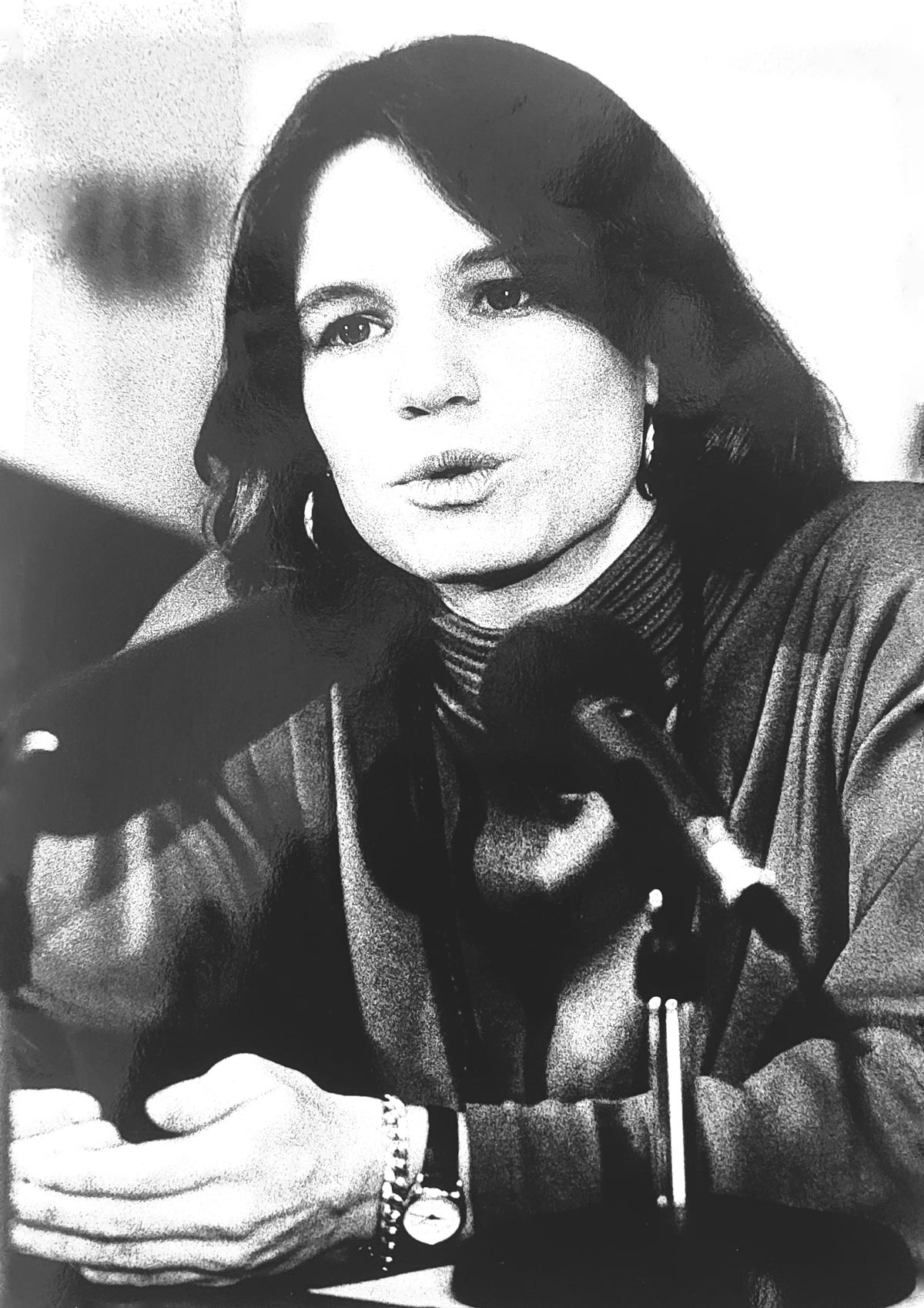
“The accusations are totally false. We are innocent and we believe the truth will come out…And it doesn’t matter if the truth doesn’t come out because we ourselves know that we are innocent.” – Jennifer Jean Casolo, Tropic Times, Dec. 6, 1989
By Greg Walker (ret)
USA Special Forces
“The military had picked up Jennifer Casolo, a 28-year-old American woman accused of being responsible for funneling several million dollars to the guerrillas. They called the base and wanted me to come over to the national police headquarters. They didn’t want the [U.S.] embassy in on this. [Paul] Fanshaw and I, along with seven Salvadoran officers, drove over in the middle of the night. The police had her locked up in a room and they wanted me to read the documents they had gotten from her a few hours earlier. I read them until 0500, and realizing their importance, made copies and kept them for myself.” — Captain Harry Claflin, Senior U.S. adviser, Airborne Battalion (ESAF) / USMC Force Recon
“Asked about the guilt of U.S. citizen Jennifer Casolo, who was released by a judge “because of lack of evidence,” the high-ranking military officer [Colonel Ponce] said the Armed Forces [was] simply following orders issued by civilian authorities. “During the investigations conducted to determine the guilt or innocence of Casolo, the National Police gathered all of the evidence and sent it to the court, which afterward ordered the release of Casolo,” Ponce added. — FBIS Concatenated Daily Reports, 1990, Document 12 of 45
“Senator [Edward M.] Kennedy threatened to cut off aid to El Salvador if Casolo wasn’t set free. So, she was released back to the United States. One of his aides picked her up in a private aircraft [Kenney’s].” — Captain Harry Claflin, “El Salvador: The Push to Victory”, SOF, August 12, 2021
“Interview with a captured ERP urban commando, March 1990, who clearly identified the [American] woman as being a member of the logistics command group of the ERP urban commandos [Jennifer Casolo].” — “Guerrilla Logistics/Support/Sanctuary”, Strategy and Tactics of the Salvadoran FMLN Guerillas, Jose Angel Moroni Bracamonte and David E. Spencer
Just a young woman from Thomaston, Conn.
Well educated, an idealist, and raised in the Catholic faith Jennifer Casolo traveled to El Salvador as a representative of a Texas-based religious organization. Christian Education Seminars, opposed U.S. military aid to El Salvador. In her role Casolo arranged tours for U.S. lawmakers, religious leaders and activists, and fellow Americans who she felt could become important influencers and allies. According to the Latin America Data Base, Casolo was a summa cum laude of Brandeis University (Class of 1983) who was an adept translator and accomplished guide in El Salvador. Attractive, upbeat, and easy to have a good relationship with Casolo developed relationships and contacts with politicians on both the Right and Left. She routinely met with Salvadoran peasant groups and senior officers with the Salvadoran military. Staff members with Christian Educational Seminars described Casolo as “a touch naïve” and “idealistic but not ideological”. She was welcomed at the U.S. embassy in San Salvador and soon became both well-liked and trusted.
However, her idealism was soon worn down and then out as both time and the war continued unabated. Journalist Tom Bates (Soldier of Fortune magazine) wrote an in-depth article in the publication’s May 1990 issue (“Church Merc Unmasked”) offering in part after reading Casolo’s diary entries and personal correspondence as seized during the raid on her home. “…one sees the thoughts of a young woman caught on the horns of a dilemma – whether to uphold the conventional norms of behavior dictated by her religious upbringing or to take, in her words, a more ‘radical’ approach in trying to combat what she sees as rampant social injustice in El Salvador…After living in El Salvador for several years her thinking, as expressed in her personal documents, became more polarized, her activism more militant…she makes no secret of her strong opposition to U.S. foreign policy in the region, and of her sympathies with the FMLN, who, she writes, ‘represent the poor…the millions of silenced cries of oppression and screams of repression.’”
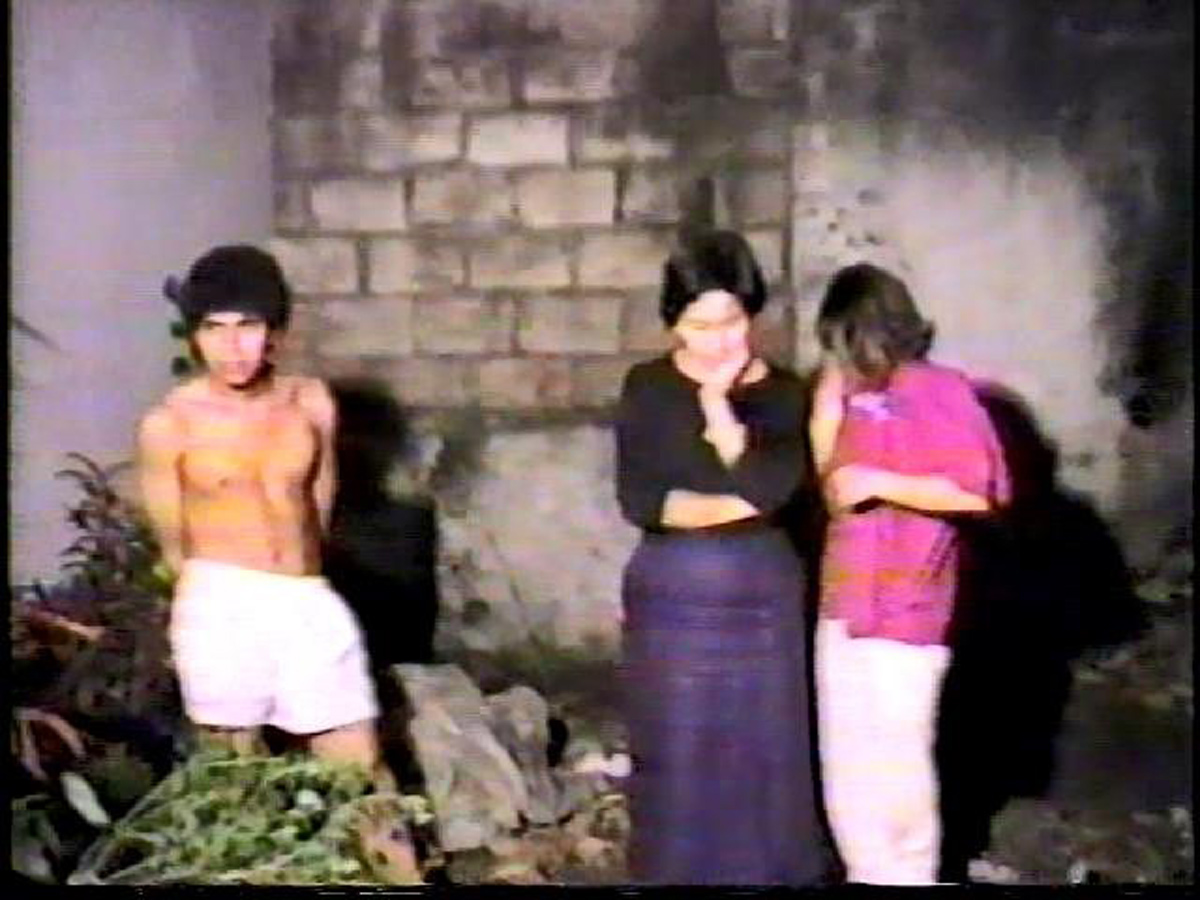
Jennifer Casolo (right) took responsibility for documents found in the living area of her rented house in San Salvador during the FMLN 1989 final offensive. Standing in her backyard area she refused to accept responsibility for the assault rifles, munitions, explosives, and grenades recovered by GOV troops. Jose Federico Vasquez Hernandez (left) was later identified as an ERP urban guerilla, was also her boyfriend. (Raid video, CEAT)
It was this trajectory that soon saw her adopt the role of a female revolutionary. Again, from her own writings – Defining the term “radical” Casolo offered a radical is “one who wants to see the revolution triumph”. Going further, “…my thoughts are too radical…my fundamental responses would touch our lifestyles, our values…my last 1 ½ years has taught me the value of risk taking…it is time to take a stand…please be selective about repeating anything I write.”
Casolo likewise shared her newfound revolutionary identity with “Larry”, with whom she’d had a close relationship back home in Connecticut. It had become more and more difficult for the young woman to visit her friends and family back in the United States. Harder to reconcile both her privileged upbringing and education with the stark contrast of her life living and working in El Salvador. Her writings reflect this dilemma. Most of all she’d come to hate putting on the public face those back home were familiar and comfortable with when in fact her views and actions back in El Salvador were just the opposite.
“I had not trusted those of you whom I love; to listen to me and still accept me if not my ideas. On on the political/spiritual level, I had revealed to myself how little I was really willing to risk. I have vowed to myself to make every effort next time I’m home to be true to myself and to the people here…to take a risk.” – Jennifer Casolo, Letter to “Larry”, San Salvador, El Salvador
Another aspect of Casolo never revealed in full was her money raising role for the FMLN.
She raised millions during her four years in El Salvador, and continued to in the states after Senator Ted Kennedy strong-armed her release. El Salvador was the first armed conflict in our hemisphere to see a sophisticated and efficient war chest funded for the guerrillas in the US. It became the model for such ventures and continues to this day on behalf of many “bad actors” causes and states to include fund raising and “humanitarian aid” for Gaza.

Contrary to her post arrest comments Casolo, as evidenced in the C.E.A.T. video made of the raid, was clearly composed and articulate in both English and Spanish during the raid. At one point she states, “My mother doesn’t even know where El Salvador is!” (Raid video, CEAT)
Going to war with the ERP
(Ejercito Revolucionario Del Pueblo) in 1989
“On November 11, 1989, nearly 3000 guerrillas from the ERP, FPL, FAL, RN and PRTC (the five armies under the banner of the Marxist-inspired FMLN) launched an all-out assault on El Salvador’s capitol city, San Salvador. The offensive, planned and prepared for months in advance, to include well stocked caches of weapons, explosives, munitions, and rocket launchers to include American made LAW rockets. Urban logistics coordinators from the ERP, in specific, obtained safe houses in which to place the caches and to provide respite from the fighting for the guerrillas. On November 26, 1989, five such safe houses were raided by the Salvadoran National Police.”
Joaquin Villalobos—ERP’s main leader and founder was Joaquin Villalobos. Villalobos’s role in the ERP was as a military strategist and playing a crucial role in negotiations during the end the civil war.
Rafael Arce Zablah (Alvarez)—Zablah was another ERP leader and key activist who gathered support from local Catholic priests. These communities became an important part of the war by serving as a base for the ERP. The ERP wanted to be the center of the El Salvadoran revolution while gaining support from the discontented and to cause a violent uprising or insurrection by performing military attacks. The campesinos were one of the ERP’s main support groups, along with the Catholic Church.
Prior to the November 11, 1989, offensive, the ERP was on the defensive carrying out the attrition strategy they had adopted in 1986. The organization had gone from their Rafael Arce Zablah Brigade (BRAZ) with its two battalions in the east, one in Morazan/San Miguel and the other in Usulutan/La Union to a more distributed organization based on platoons and squads.
They could concentrate on occasional attacks based on the principle of coming together for an operation and then immediately dispersing back to their squad and platoon formations, something they called “concentration and deconcentration.”
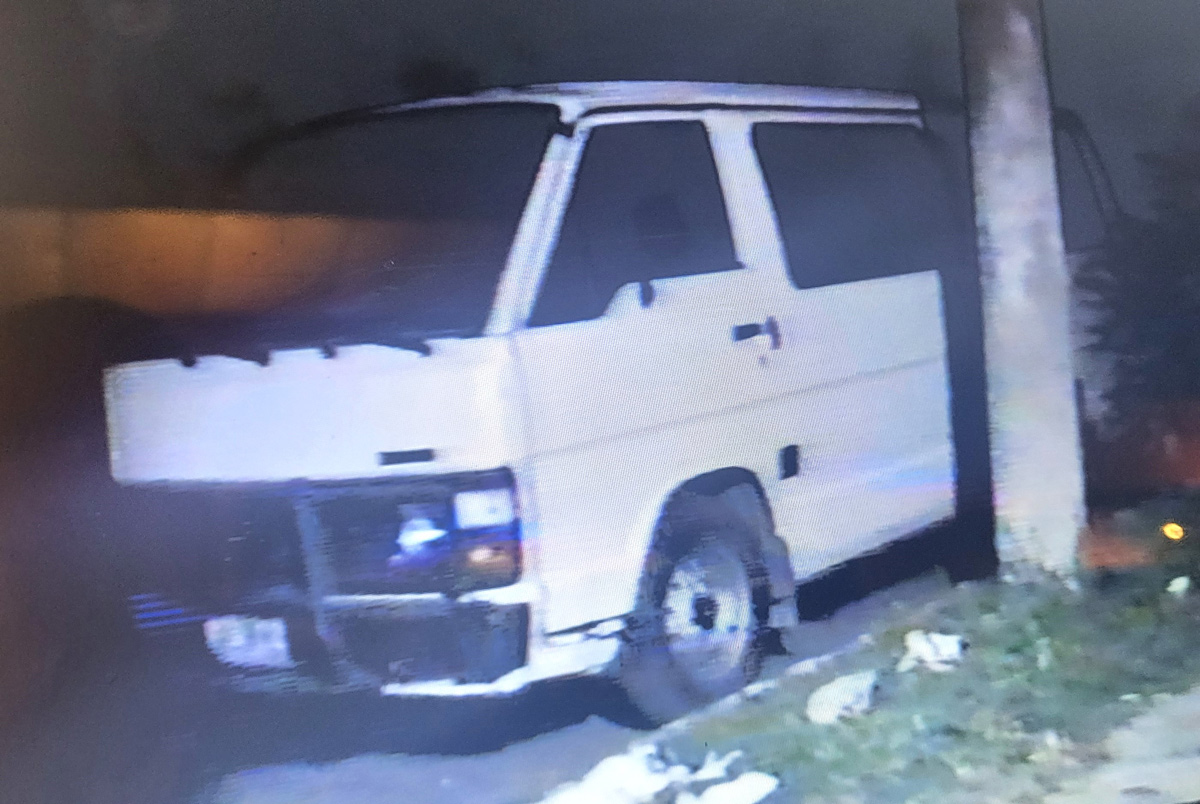
Jennifer Casolo’s van was found parked outside her house the night of the raid. “Tico”, a former ERP urban guerrilla who, along with Casolo, conducted soft recons of selected targets such as the Sheraton Hotel complex, and pre-positioned weapons and munitions for ERP fighters throughout the city, identified Casolo as an ERP logistician after his capture in 1990. Becoming a police officer after the war he is now in exile in North America due to the political oppression in today’s El Salvador. (Raid video, CEAT)
Negotiations had been concluded in 1987 or 1988 for a large shipment of new Soviet-Bloc weapons to replace the worn-out Western made weapons from Viet Nam and other Marxist nations which had previously been supplied by the west. The ERP was slowly introducing these onto the battlefield under the lie that they had been sold by the Contras to FMLN, after the US Congress had cut off their funding. A large number were also being shipped in and stored for the upcoming offensive. These mostly came in semi-trucks, packed in secret compartments in Nicaragua that would drive through Honduras and then into El Salvador. Only a very small circle of highly trusted members of the ERP high command knew anything about these shipments and they were not yet distributed to the troops.
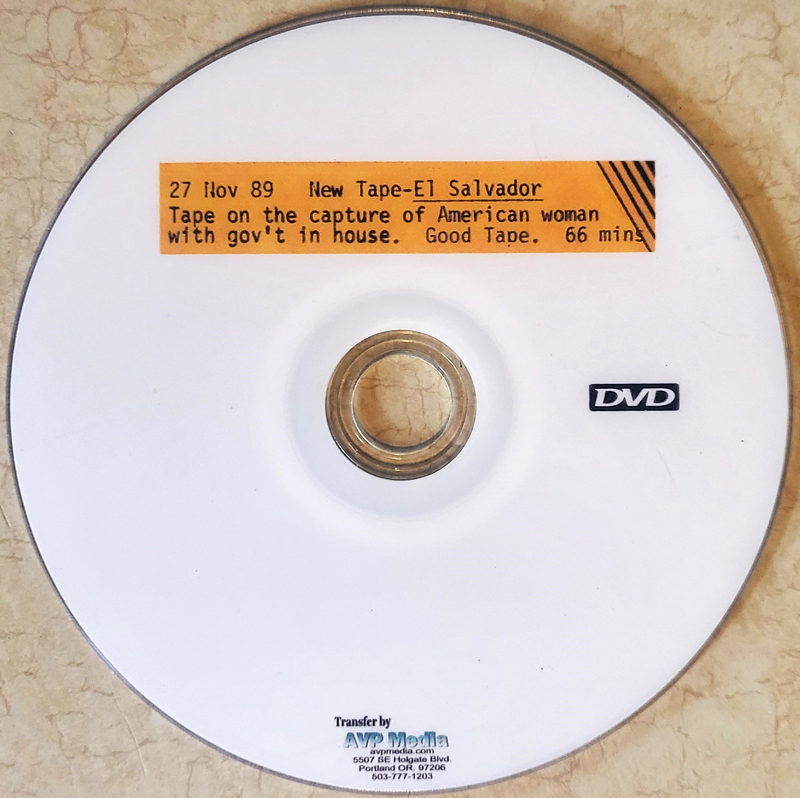
The Salvadoran National Police recorded the raid on Jennifer Casolo’s house. U.S. embassy officials under pressure from the U.S. State Department and Senator Ted Kennedy attempted to seize Casolo’s personal papers and photos as found in the weapons cache and recorded in the video taken by C.E.A.T. Unknown to Casolo at the time of the raid, one of those present and masked was a CIA paramilitary who witnessed the entire operation. Whenever Casolo would ask him, “Are you an American?” he would reply, “Nyet!” (Author collection)
The ERP was also pushing to establish a significant presence in the main cities. The ERP now sought to establish numerous urban commando cells. These were formed and began to carry out low level operations in the San Salvador area. This effort coincided with the revival of mass organizations that in the new more democratic environment, fostered by the United States, began to carry out numerous social protests in the capital area. The ERP strengthened its presence on the slopes of Guazapa volcano and San Salvador volcano to administer this growing urban commando/social protest presence. The command structure for the 1989 offensive was in this region. The ERP did not revive their guerrilla units in western El Salvador, but rather established logistical hubs there where aid and logistics came in from the United States, Mexico and Guatemala. Pro-ERP college students in the United States, particularly in California would buy used vehicles and build secret compartments which they would fill with military caliber ammunition that was freely available on the US market. These vehicles would travel through Mexico along routes where the Mexican officials were either sympathetic to the cause, or paid off. Once they arrived in El Salvador and their cargos were removed, these vehicles could either be incorporated in the war fronts or sold on the thriving used car market in El Salvador.
In the United States, the ERP also carried out significant fund-raising activity through NGOs such as the Committee in Solidarity with the People of El Salvador (CISPES). Donors were told their money was going to support war refugees, but most of these donations were handed directly to the guerrillas. Jennifer Casolo was tied to and involved with CISPES during her efforts on behalf of the FMLN and ERP in El Salvador
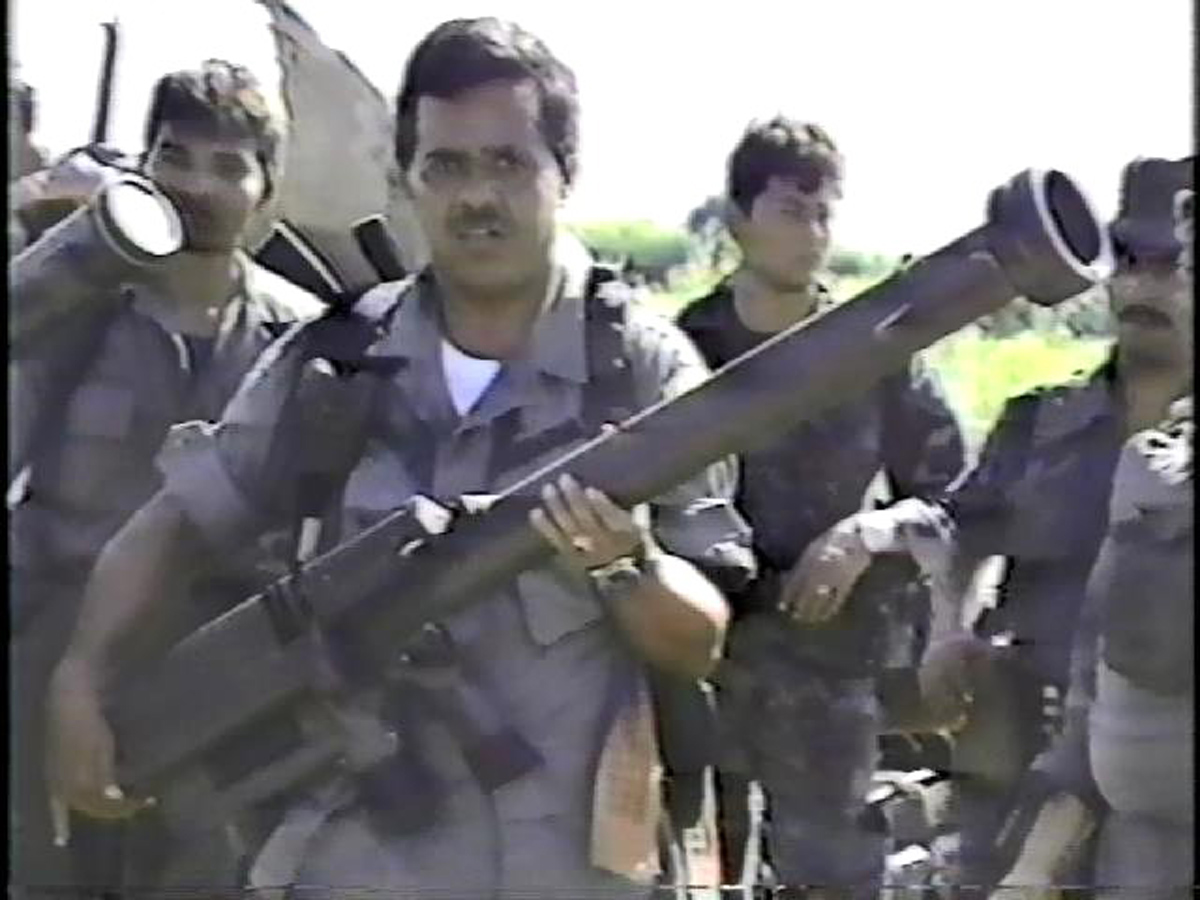
The ERP pressured the Sandinistas to provide them MANPADS (shoulder fired missiles), but they refused because they feared that it would be used as an excuse by the United States to launch an invasion. Here, Salvadoran troops hold surface to air missiles found in the wreckage of a small plane piloted by a Sandinista pilot (killed in the crash) in 1989. All the weapons and munitions recovered were traced back to Nicaragua which was the major supply hub for the FMLN during the war – Author collection
While most of the major weapons, ammunition, explosives, and other supplies came to the ERP from the Eastern Bloc and Cuba via Nicaragua, this did not include a lot of cash, so these donations were important and Jennifer Casolo became an expert fund raiser for the FMLN/ERP. Starting in late 1988, the ERP began to create the infrastructure they would need to participate in the 1989 offensive. They developed a series of routes into the capital both south from Guazapa and the San Salvador volcano as well from the east, into the Zacatecoluca area and up through the foothills from the south. Trails were blazed, camps were built and weapons and ammunition were pre-positioned. A large number of safehouses were acquired in San Salvador to include Casolo’s rented home and arms caches deposited there as well. Some lesser cities also received a similar treatment like San Miguel. The plan was to invade the periphery of the capital, fortify their positions to force the government to attack them, provoke the uprising, arm the people and with luck either take power or come to a stalemate that would force the government to negotiate.
“Among Casolo’s papers were a series of love letters and maybe journal entries. She was totally in love with this guy who was clearly a guerrilla. I got some stuff, but I was mostly interested in her activities in support of the FMLN, rather than her personal romantic life.” – U.S. intelligence analyst to author, January 11, 2024
Casolo had developed a relationship with a young man who was a guerrilla – he was killed in a firefight with government forces and she is described as having had a tough time once she learned of his death. So distraught was the young woman that she nearly left El Salvador – but the FMLN / ERP who were her handlers convinced her to stay. They set her up with a new boyfriend as part of their effort. Her fund raising by deception soliciting money for food, clothing, shoes, and so on from stateside churches and NGOs but turning the donations over to the FMLN appears to be one very good reason the FMLN wanted her released / deported. Seen as a victim and not an ERP combatant Casolo could still be a productive voice in the United States. Also, the FMLN demanded the documents seized to include her bookkeeping records be returned to her. The U.S. embassy in San Salvador likewise received intense pressure from the U.S. State Department to secure the documents and the video, much of this emanating from Senator Kennedy’s staff. The material if made public would have been a disaster for her as well as a huge victory for the Salvadoran government in terms of favorable propaganda/press. In addition, Casolo’s true role would have undermined Kennedy’s years long effort to see military aid to El Salvador stopped and his proposition that a negotiated settlement between the FMLN and the Salvadoran government take place.
“Face Off” with Ted Kennedy 1990 — https://www.jfklibrary.org/asset-viewer/archives/emksen-au0008-014-012
Note: Sound recording of the radio program “Face Off.” Senator Edward M. “Ted” Kennedy of Massachusetts and Senator Alan K. “Al” Simpson of Wyoming debate whether the United States should stop providing military aid to the government of El Salvador. The episode aired on Monday, February 19, 1990, on the Mutual Broadcasting System.
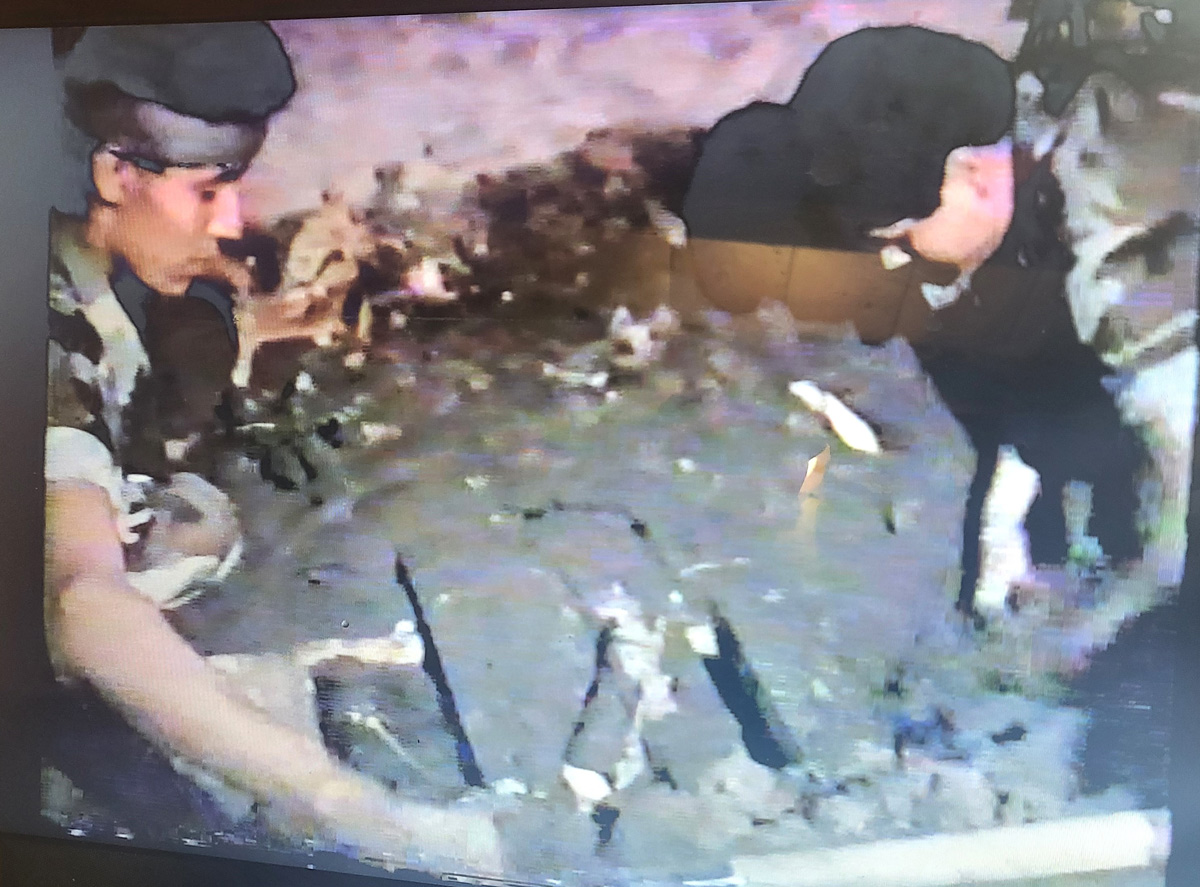
Salvadoran soldiers discovered carefully constructed cache locations in Casolo’s backyard. Beneath wood planking were found steel and blue plastic barrels filled with weapons and munitions. Casolo, in her role as an ERP logistician, was deduced to have allowed urban guerrillas access to her home. (Raid video, CEAT)
“She was a real piece of work.”
“I went to the police station and read all the material that was taken and talked to Jennifer for a short time while she was in custody. All she wanted to do is get put in the American embassy and out of Police hands. After the Embassy figured out they could not keep her arrest covered up they had a display put out for the news media. I had met Jennifer several times on different bases. I still think she was running recon for the FMLN as to how many troops were out on weekends by passing out flyers and showing TV stories on God. By passing out flyers she could have a pretty good count of who was out on patrols and how many were left on base. By wearing a face mask and talking to her in very broken Spanish she never figured out who I was. What happened at El Paraiso can be laid on her. She should have been charged with helping the FMLN set up the camp for attack. I will always blame this tragedy on her…when I talked with her at the national police station she knew she was fucked.” – Harry Claflin, U.S. adviser ESAF Airborne Battalion / USMC Force Recon
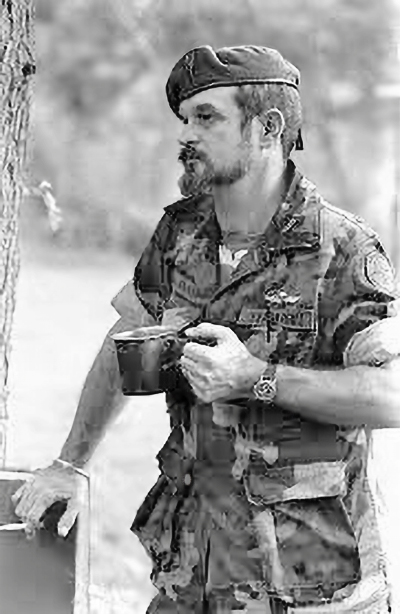
Harry Claflin is a USMC (Force Recon) veteran. Claflin, commissioned as a captain in the Salvadoran military, spent nine years in-country as a U.S. military adviser with its most elite units. Claflin recalls seeing Jennifer Casolo as she was boarding Senator Ted Kennedy’s private jet. “She saw me and flipped me the bird,” he recalls. “She was a real piece of work.”
The first American combat advisor killed in combat
Relatives of SSG Gregory A. Fronius, a 28-year-old Green Beret sergeant, were told he was slain during a guerrilla attack on the Salvadoran brigade’s headquarters at El Paraiso. They were informed Fronius had died in his barracks while asleep when a mortar shell struck. In fact, Fronius had bolted from the barracks to rally Salvadoran soldiers for a counterattack. Fronius, fighting alone from an elevated position, bought… Click here to read more.
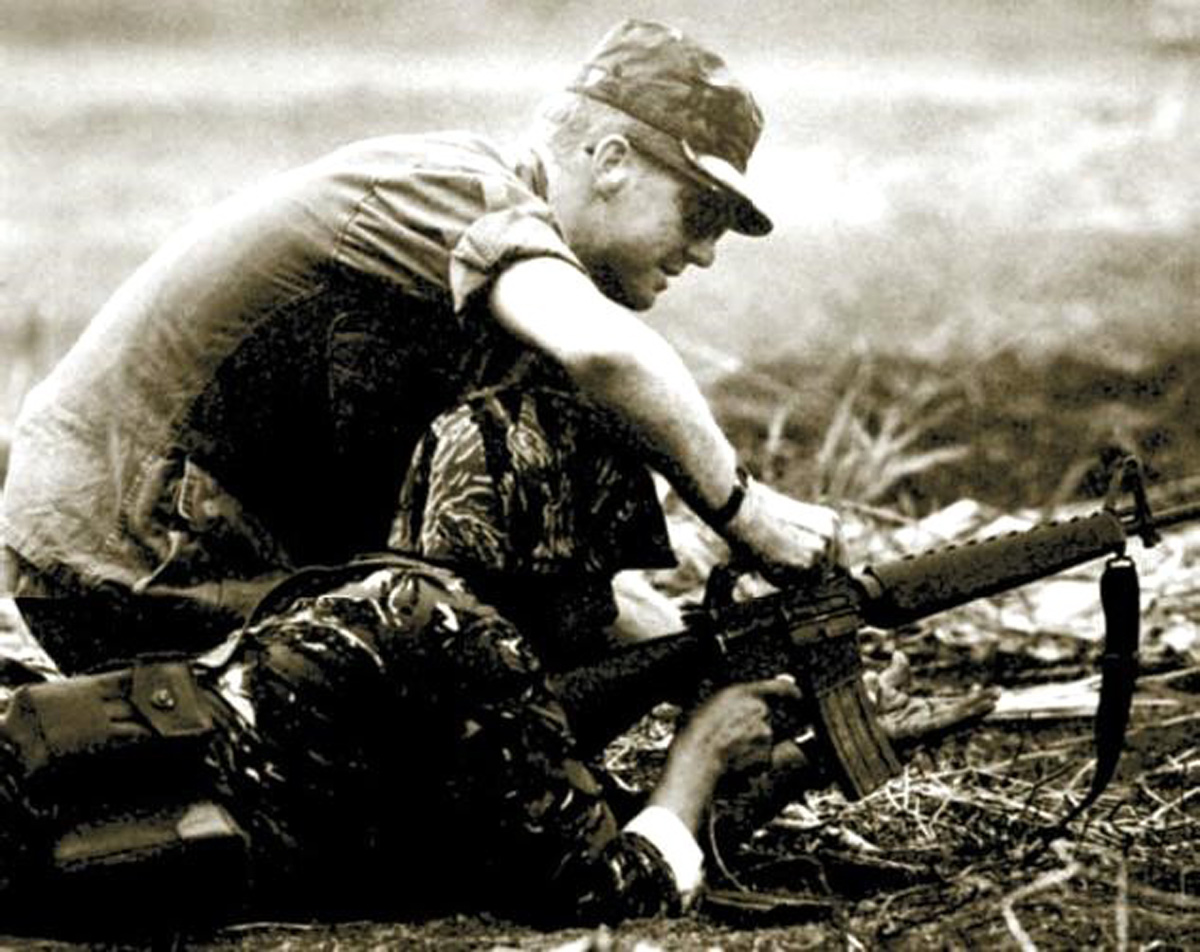
SFC Greg Fronius received a posthumous Silver Star for his courageous actions during an FMLN attack on the 4th Brigade base at El Paraiso. Severely wounded, guerrilla sappers placed an explosive charge beneath his body and then detonated it. Jennifer Casolo visited 4th BDE prior to the attack and some attribute Fronius’ death to her intelligence gathering effort on behalf of the guerrillas.
“Guardian of weapons”
“In a sign of that pique, Colonel Ponce said on Thursday that he would advise against releasing and expelling Ms. Casolo if she is convicted. In a previous interview, he had indicated a willingness to release her.” — “Salvador Says Rebel Now Ties American to Arms”, New York Times, December 9, 1989
Several weeks before Casolo was arrested a female ERP guerrilla, “Sandra”, was taken into custody. Her 33-page statement to Salvadoran police included specific names of those her urban guerrilla cell was working with in San Salvador. Sandra was specific. Casolo was described as the “guardian of weapons” for the ERP. Because the young church worker had cultivated a very cozy relationship with Colonel Rene Ponce, whose position with the Salvadoran military authorized him to issue travel passes to trusted individuals. Among Casolo’s papers were several such passes. One such pass allowed Casolo to travel to Jucuaran in the department of La Union. Jucuaran was a known stronghold for the ERP where weapons and munitions from Nicaragua were received and stored.
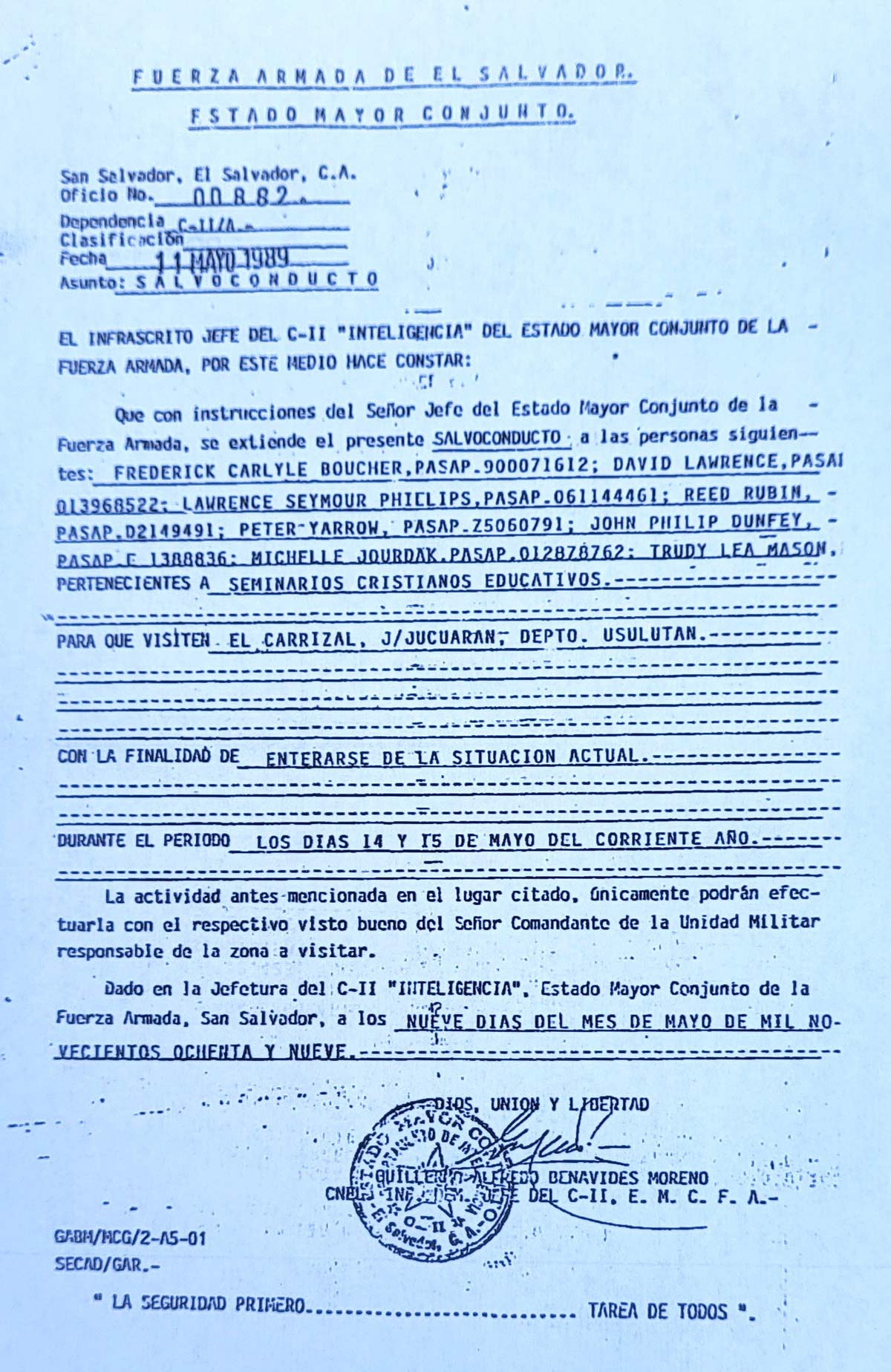
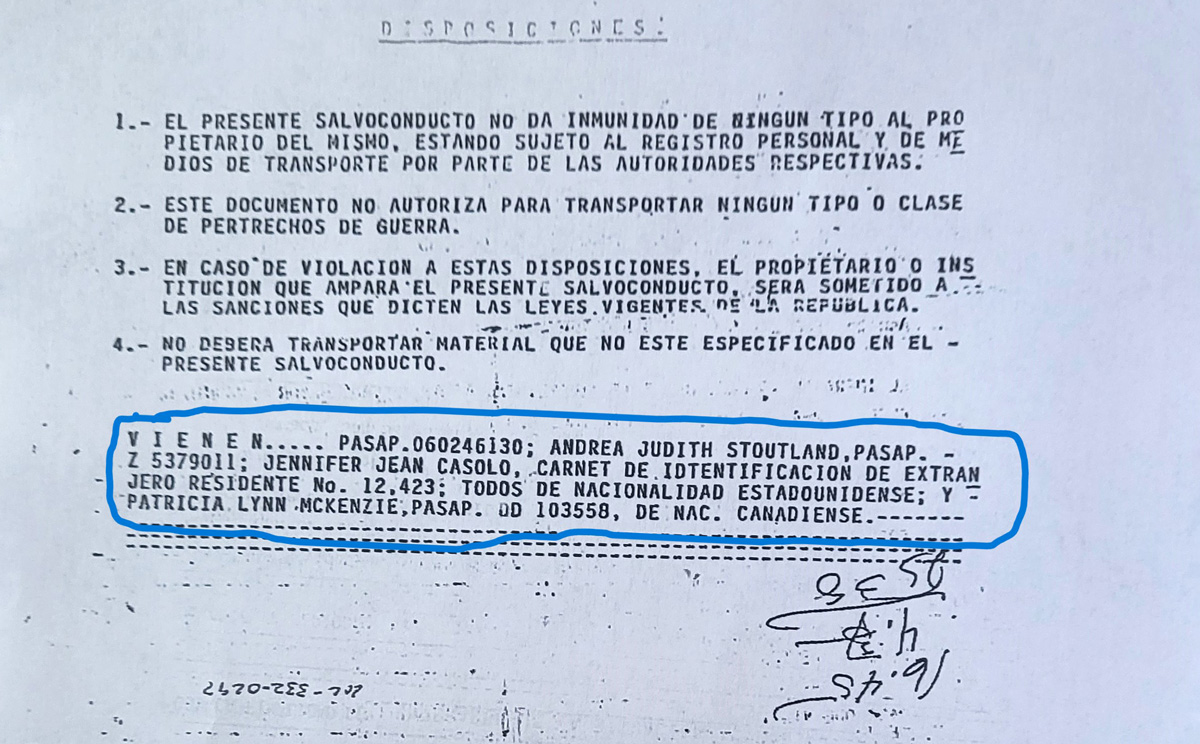
At left, Casolo’s safe passage pass (front and back sides) issued in May 1989 for the claimed purpose of Christian education seminars. “…the FPL and ERP, organizations with the greatest number of people, resources, and experience, had warehouse size caches located at strategic points such as El Tigre Hill, Usulutan and Jacuaran, La Union. These were used by the ERP.” – Strategy and Tactics of the Salvadoran FMLN Guerrillas, Bracamonte / Spencer, 1995
“Tico”, a significant leader in the ERP, shared with a U.S. intelligence analyst years later that he was responsible for bringing weapons for the 1989 offensive into San Salvador from the arsenals in Jucuaran. To do so Casolo would obtain a travel pass to the town from Colonel Ponce who believed she needed it to take a group of church and NGO representatives there. In reality, that was a cover story to go to Jucuaran with Tico, link up with her ERP logistician counterpart, and then bring the weapons back to San Salvador in her van to be then pre-positioned for the coming fight. According to Tico her home was a central distribution hub from which weapons would then be distributed to other ERP units in the city as well as their safe houses.
“Sandra”, another ERP guerrilla, drew a wire diagram of her cell’s Command & Control structure after she was arrested. Her cell was one of those Casolo stored and then distributed weapons and munitions to.
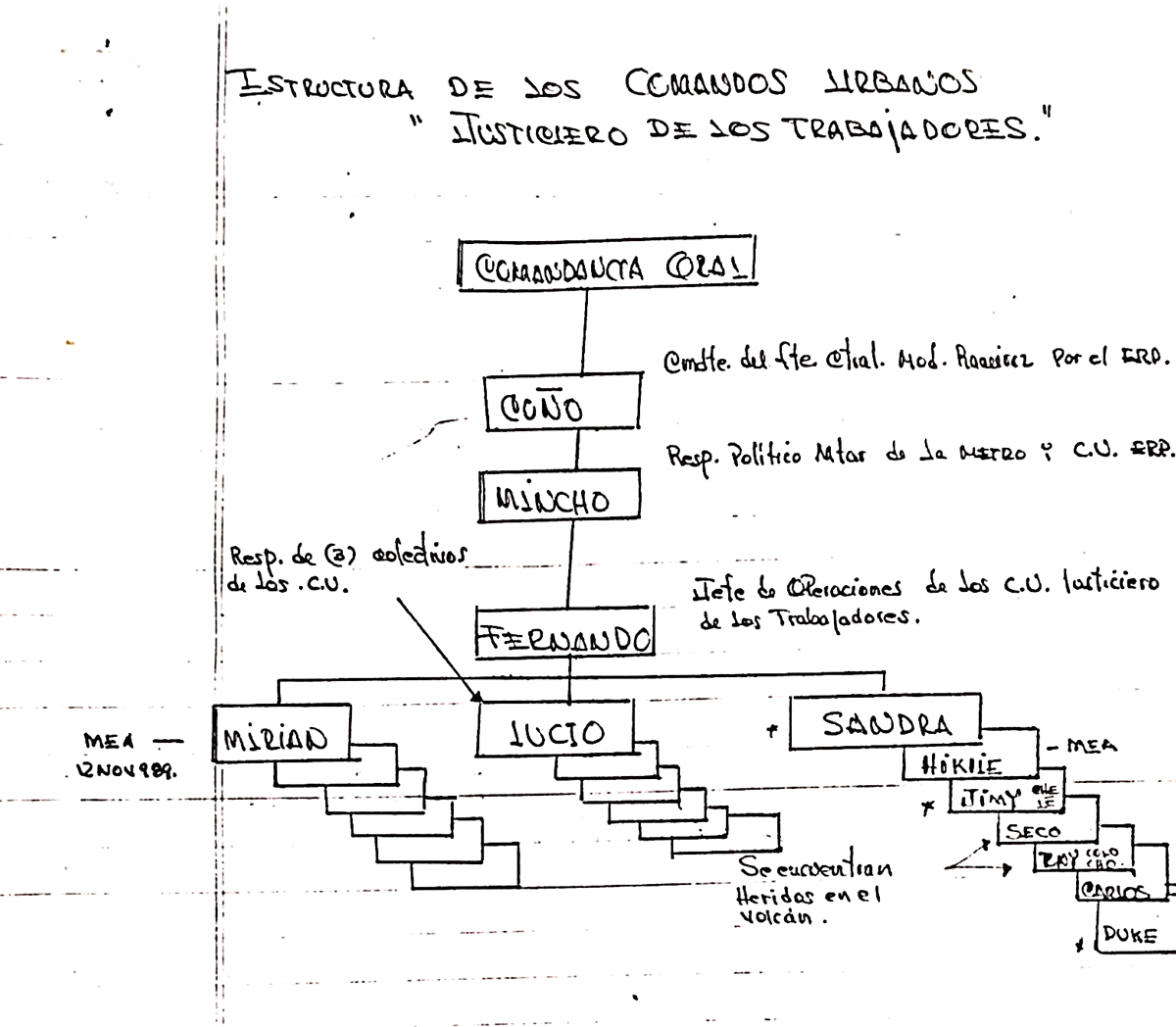
Above, “Sandra”, captured several weeks before Jennifer Casolo was arrested, produced this diagram of the ERP command structure to include naming herself and those in her cell. She identified Casolo as being the “guardian of weapons” for the ERP in San Salvador. (Author collection)
Recovered from atop one of the sealed blue plastic barrels from her weapons cache were documents from her wallet/purse, her U.S. passport, copies of her safe conduct passes, and more. Summaries from ten other ERP guerrillas likewise confirmed her as transporting and storing / distributing weapons for the offensive.
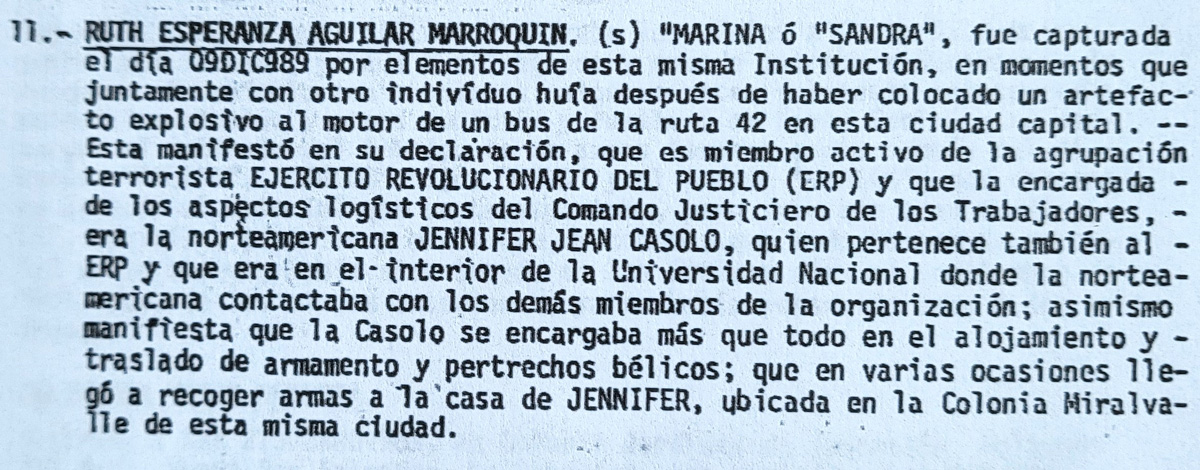
“Sandra” was actually captured several weeks before Casolo was arrested. She would identify the American woman as the ERP’s weapons logistician in San Salvador and provide a detailed organizational diagram of the ERP to include her cell. “Sandra”, or Ruth Esperanza Aguilar Marroquin, her real name, confirmed she’d picked up weapons for the offensive from Casolo at her home in San Salvador.
Casolo was looking 30 years in a Salvadoran prison and she knew it. Her only hope was to appeal to her family and friends in the United States to exploit her American citizen privilege in escaping Salvadoran justice. “She knew people in high places in El Salvador and in the U.S.,” recalls Harry Claflin. “She grew up next to the Kennedys in Massachusetts and used her influence to get what she wanted. Kenndy sent a plane down to get her. I was at Ilopango when they came down to get her. Kennedy told the Salvadoran government if they did not let her go he was going to cut all aid to the country.”
Where Casolo, after several weeks in a women’s’ prison at the Illopango military airport, skated free and went home to continue her claims of innocence, those others captured were not so fortunate. Had Casolo walked her talk and stayed to stand trial in El Salvador it is as likely as not that Kennedy would have kept his word. Had that been the case there is no telling how much longer the war would have continued…and who might have triumphed in the end.
Targeting American Special Forces
“On November 11, 1989, twenty armed guerrillas stormed the Sheraton Hotel in downtown San Salvador and held more than 100 people hostage, including several U.S. Green Berets in the city to do a training mission and Secretary General of the Organization of American States, Joao Baena Soares. Release of the hostages was negotiated by the government, the Roman Catholic Church, the Salvadoran Red Cross and the FMLN. Several days later the violence continued with the killing of Padre Ellacuria and several other Jesuits at the Central American University.” — El Salvador, the Sheraton Hotel Siege and the Jesuit Murders – November 1989, ADST
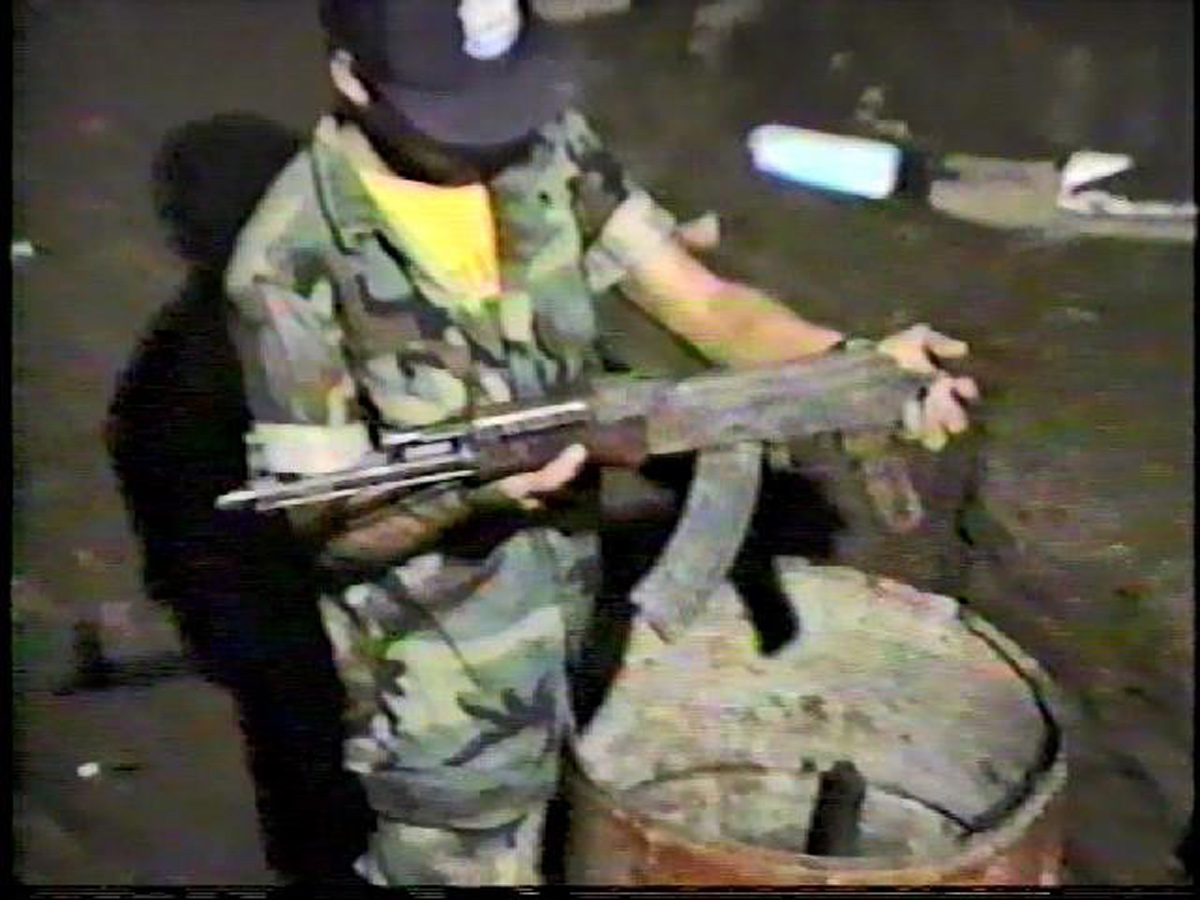
“In 1988, the FMLN decided to completely change and update its arsenal…By 1989, this included AK-47 rifles, Dragunov sniper rifles, RPK and PKM machine guns, RPG-18 and RPG-7 individual anti-tank weapons…”. The Casolo cache included AK-47s, thousands of rounds of ammunition, hand-grenades, and plastic explosives / detonators. (Strategy and Tactics of the Salvadoran FMLN Guerrillas, Bracamonte / Spencer, 1995)
As the 1989 final offensive began it was clear Jennifer Casolo was “all in”, as one U.S. intelligence analyst describes her. She’d used her position as a peaceful church lay worker to garner millions of dollars in donations for the FMLN and was considered a significant and influential proponent for non-violence. In her role as the ERP’s weapons logistician in San Salvador her impressive salesmanship within the U.S. embassy and Salvadoran High Command had provided her with invaluable credentials and safe passage passes, both which she used to move guerrillas, weapons, munitions, and more from the outlying guerrilla base camps and caches into San Salvador. Her intelligence gathering missions to the various Salvadoran bases, under the guise of Christian education, provided the FMLN with critical information about manpower, the layouts of each base, and the morale of the troops. In 1987, one such recon resulted in the combat-related death of an American “Green Beret”, SFC Greg Fronius.
The Sheraton Hotel complex had long housed VIP and U.S. military personnel. It had also been the site of past killings. In 1989, security around the hotel was tight. But with her safe conduct pass and a familiar face at the Sheraton (Casolo stayed there for when she felt unsafe) she had no problem when “Tico” accompanied her to recon what was an ERP target for the offensive.
The North Tower was where most in-country Special Forces advisors stayed when in the city and this, too, was well known. The attack on the Sheraton included either capturing or killing any U.S. advisor who may have been staying there and in this case there were several. Barricaded and well-armed the Green Berets held out until the guerrillas were forced to depart.
Casolo had long since crossed the line when it came to putting her fellow countrymen and women in Harm’s Way. She’d lost the zeal she’d originally brought to El Salvador as a church worker; she’d lost faith in her government due to its ongoing and increasing support of the war effort; she’d lost faith in the Salvadoran government and its military to ever cease its abuses; she’d lost a lover and her new boyfriend, also a guerrilla, was facing the same fate. In addition, the young ERP logistician had made many close friends among the ERP and FPL. This included Maria Serrano (FPL) who had lost a daughter to the Army’s brutality and was fighting in the mountains. Casolo, again using a safe passage pass, had visited Serrano at her base camp and introduced her to visitors she’d brought with her.
American embassy guards, aviators and crew members, a Navy SEAL and a “Green Beret” had already been targeted and killed by the FMLN. For Casolo, they were not supposed to be there doing what they were anyway. She was no longer “Jennifer from America”. She was an ERP fighter and a superb organizer, coordinator, fund raiser, and intelligence gatherer. There could be no victory without risk and she was willing to risk it all in 1989.
“She and a former guerrilla friend of mine who later demobilized and became a policeman drove around prior to the offensive reconnoitering objectives and pre-positioning weapons. They were using her van and access as cover. She was all in, no doubt,” recalls the U.S. intelligence analyst who has studied the Casolo case.
The Raid
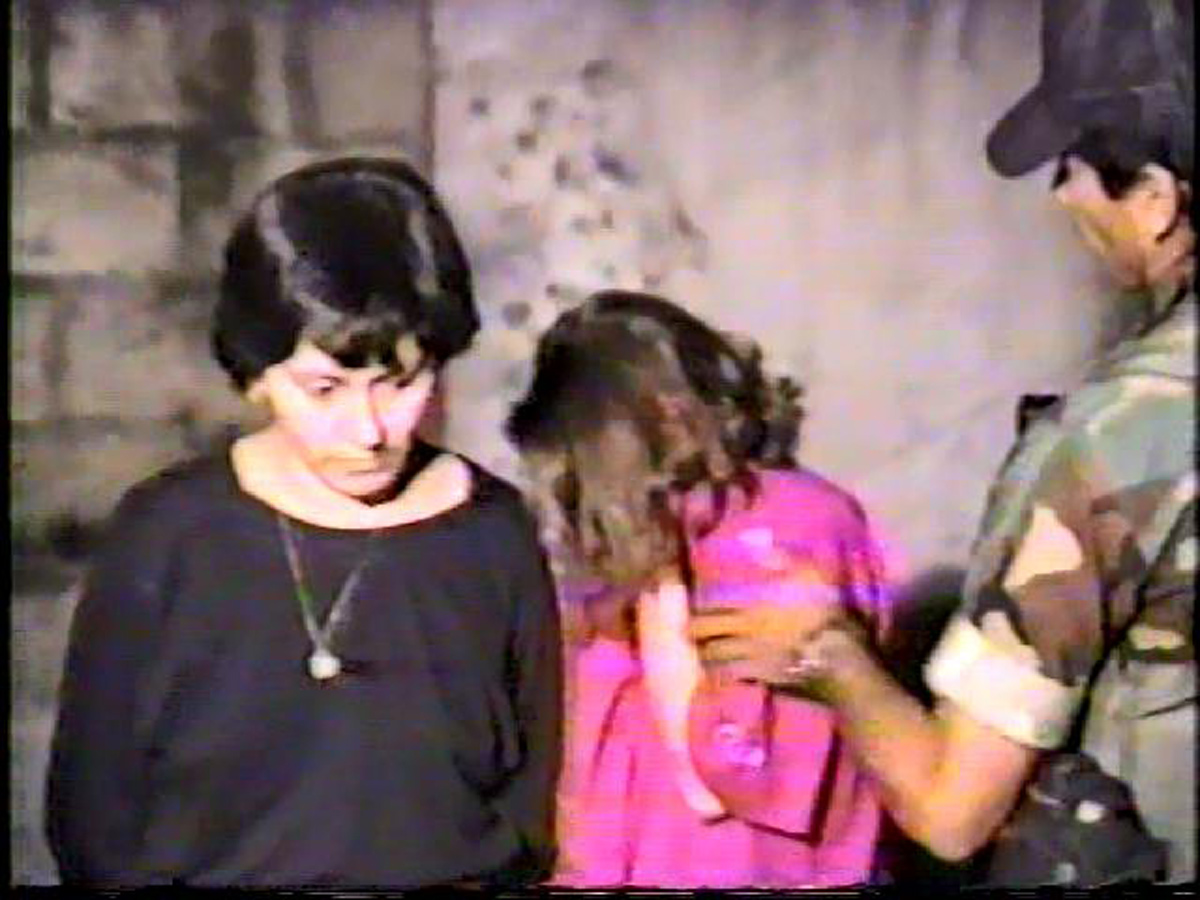
On November 26, 1989, the National Police conducted a six-hour search of Jennifer Casolo’s home in San Salvador. “Somebody hates me or somebody is trying to frame me,” she told police. Casolo (right) was arrested along with Maria Guadalupe Castro Torres who she offered was simply visiting. Guadalupe was from Guazapa. War materials seized from her garden included 103 60mm mortar rounds, 405 detonators, 213 blocks of TNT, 150 feet of slow-burning fuse, 3 crates of AK-47 rifles, 12,510 rounds of AK-47 ammo, 9,110 rounds of M-16 ammo, and 325 rounds of G-3 ammo. In addition, there were hand grenades and instructional materials. (Raid video, CEAT)
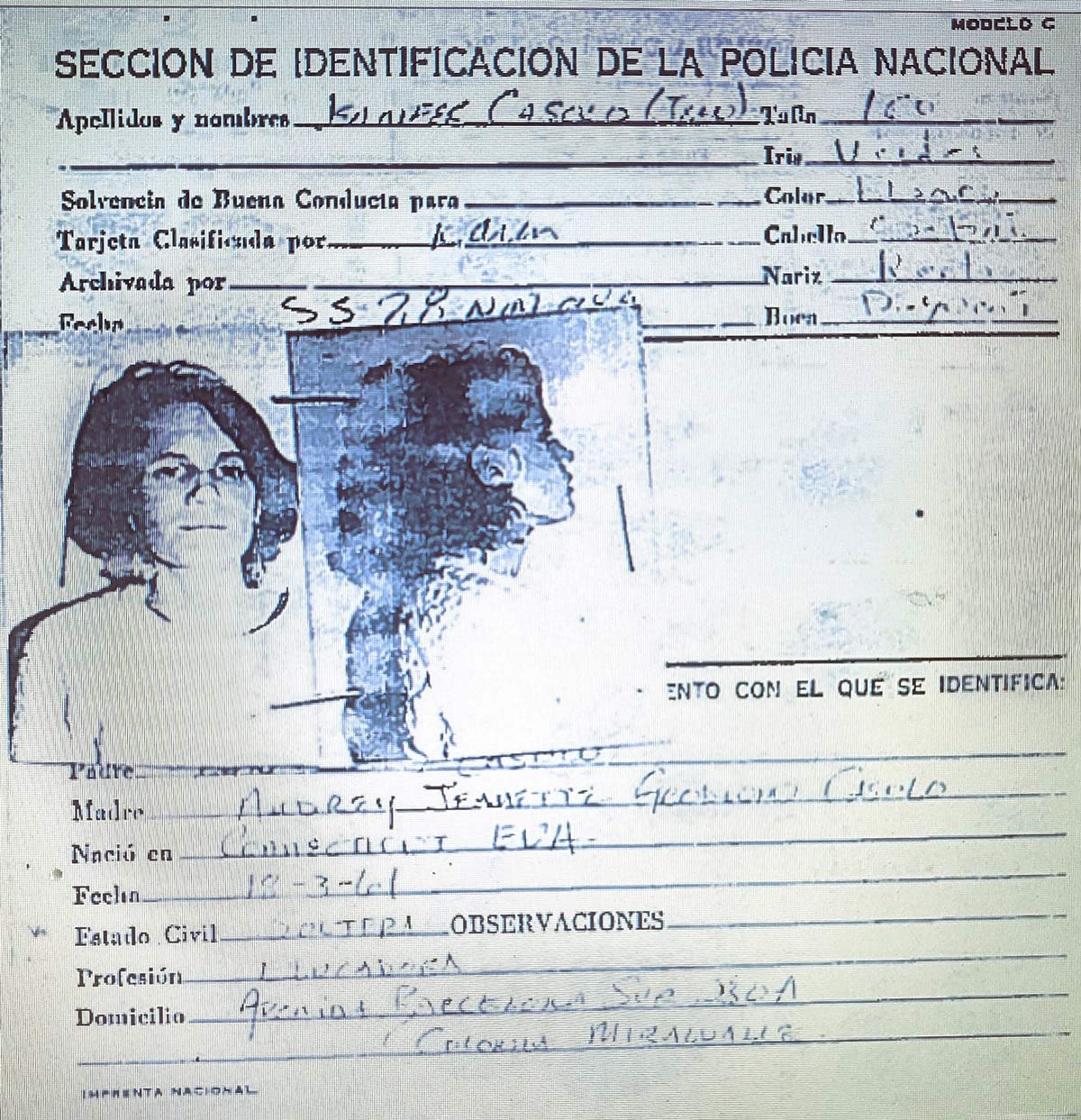
Upon her arrest Casolo was fingerprinted and her mug shot taken by the National Police. (CEAT)
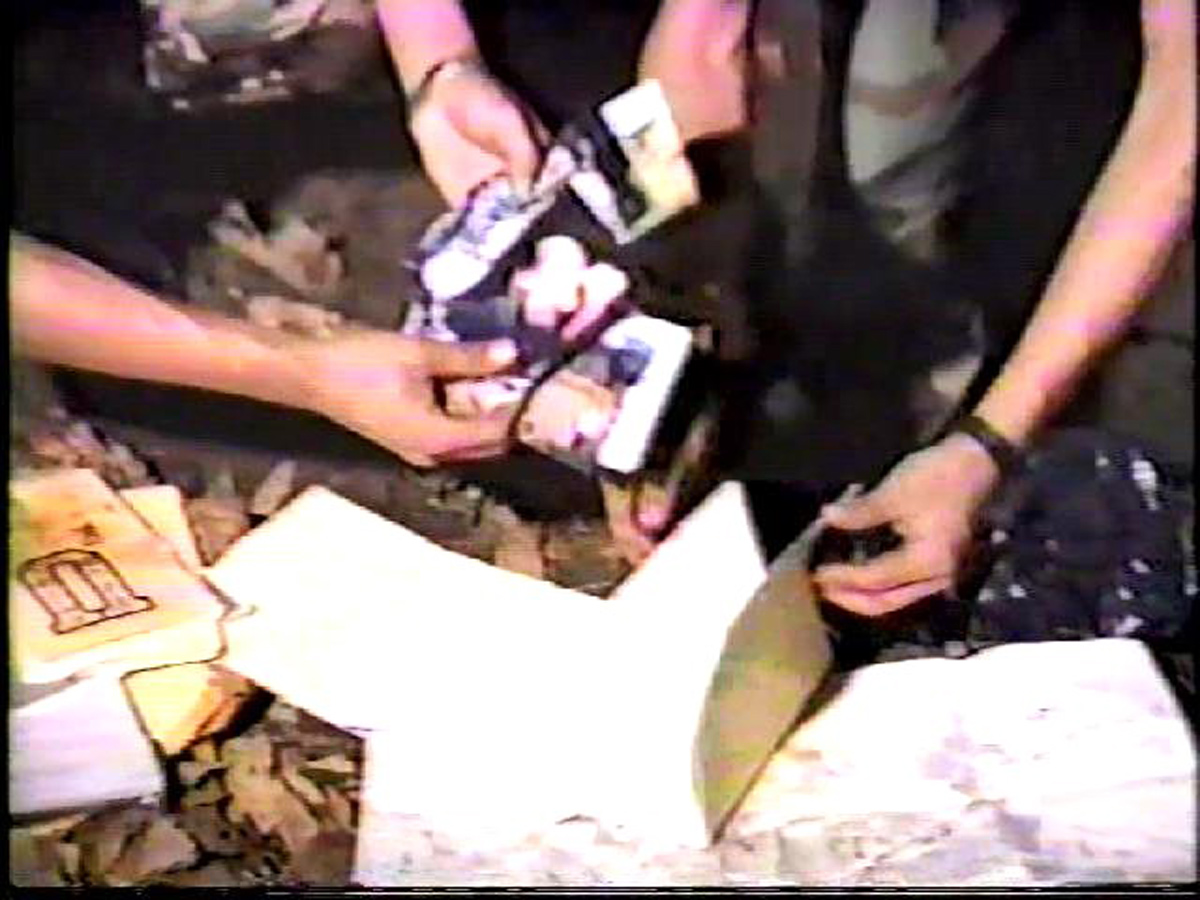
Left, photos of Casolo meeting with identified FPL / ERP guerrillas and leadership – CEAT
Admit nothing, Deny everything, Make counter accusations
“In Peru, [Lor] Berenson met members of the Túpac Amaru Revolutionary Movement (MRTA), a group accused of committing terrorist attacks in Peru including kidnapping, bank robberies, extortion, hostage taking, and assassinations. Berenson initially denied knowing that they were MRTA members. After acknowledging that her associates were members she maintained that she did not know the group was planning to conduct an attack on Peru’s Congress or planning any other act of violence.” — https://en.m.wikipedia.org/wiki/Lori_Berenson
“Ana Montes was US Intelligence’s ‘Queen of Cuba’. The Defense Intelligence Agency’s leading Central America analyst; go-to voice on Cuban intentions and capabilities; eldest daughter of a family dedicated to US Government service. She was also a Cuban spy her entire professional life, until arrested 10 days after the 9/11 terrorist attacks. Now, after almost 21 years in prison, Montes resides in Puerto Rico, an unrepentant critic of US policy towards Cuba.” —
https://www.aspistrategist.org.au/last-of-the-true-believers-or-harbinger-ana-montes-and-the-future-of-espionage-against-the-west/
Lori Berenson, an American, joined CISPES and was active in support of the FMLN before becoming involved with MRTA in Peru. For her crimes there as a terrorist she was sentenced to 20 years in prison. Ana Montes, an American, would serve a similar sentence in a U.S. prison for her role as a spy for Cuban Intelligence. Neither had the political leverage back home that Jennifer Casolo benefited from. Her several weeks in a Salvadoran women’s prison, constantly monitored by the U.S. embassy on behalf of Senators Chris Dodd and Ted Kennedy, pale in comparison to what Berenson and Montes experienced upon arrest, conviction, and sentencing.
Click here to read the handwritten statement Jennifer Casolo provided to the National Police after her arrest. Never before published the statement, signed by Casolo, was an effort to claim her innocence of all charges. Unfortunately for her, a senior Salvadoran officer sent the majority of what was recovered from her living area and backyard to the United States in a diplomatic pouch. Once opened and read the material was a treasure trove of information, donor lists, and hard intelligence the Salvadoran and U.S. intelligence analysts put to good use. —Greg Walker, author
Casolo returned home and began a 9-city public relations tour. Her celebrity and cover story of being persecuted for merely promoting church activities received national attention and raised yet more funds for the FMLN.
During this tour, Casolo gave this 52-minute radio interview with Studs Terkel. It offers a rare insight into her thought processes and motivations—and is insightful as to her conversion to Marxism and her ultimate role as an ERP urban guerrilla organizer and logistician.
Today Jennifer Casolo “is a geographer based in the Maya Ch’orti’ territory (Guatemala-Honduran borderlands). Working in and/or on Central America since 1985, she is serving presently as Rector of the Ch’orti’- Maya Pluriversity, a post-doctoral researcher with the Institute of Development Policy with the University of Antwerp, an associate researcher with Nitlapan Institute, Central American University, Managua, Nicaragua.”— https://www.resilience.org/resilience-author/jennifer-j-casolo/
“There were a lot of them and almost all women. Lori Berenson who ended up in jail in Peru for helping the MRTA was helping the FPL at the end of the war. All of these young ladies were radicalized by East Coast professors. Ana Montes as well, ended up spying for the Cubans inside DIA. Apparently was recruited before she joined the agency and then the DIA. Makes you wonder how many more are out there that we don’t know about.” – U.S. Intelligence Analyst
Dedication
Lieutenant Colonel (ret) Lucius “Gus” Taylor and I served together in Central America. We later became good friends and it was Gus who provided the critical photos and documentation that ultimately resulted in SFC Greg Fronius, KIA, being awarded a posthumous Silver Star.
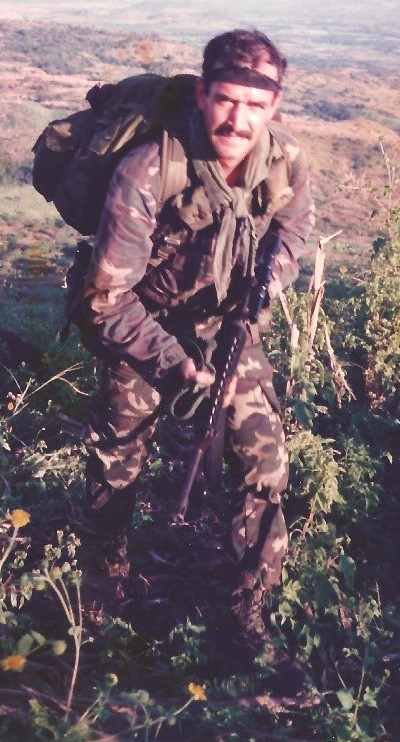
Lieutenant Colonel (ret) Lucius “Gus” Taylor
After Fronius was killed at El Paraiso (1987) it was then Major Taylor, his mission commander, who mounted a U.S. MilGrp authorized month-long operation to track down and eliminate the guerrillas who participated in the attack and killing of his teammate. With another SF advisor / sniper and a small team of Salvadoran snipers Taylor roamed Chalatenango Province, hitting the enemy wherever they were found. He shared portions of that operation with me in 1995 when I visited with him in Panama while supporting SOC-SOUTH at Task Force Black.
Taylor served twenty years in the Army, and more than twenty years at NSWC Crane. As a Chief Engineer, Taylor serves in a division with around 200-people devoted to weapon systems engineering for the US Navy, US Marine Corps, and US Special Operations Command. Until recently, he served frequently in Afghanistan, Europe, Africa, and other deployed locations.
Gus recently passed away. He is remembered, honored, and missed by his fellow Green Berets.
RIP, Warrior, RIP.
Click here to read “No Fallen Comrade Left Behind,” where Gus Taylor shares his account of the death of SFC Greg Fronius. In this account, he identifies two American citizens (one of whom was Jennifer Cosolo) who gathered intelligence for the FMLN in El Salvador, which he assigns responsibility for the attack on El Paraiso in which SFC Fronius was killed in action.
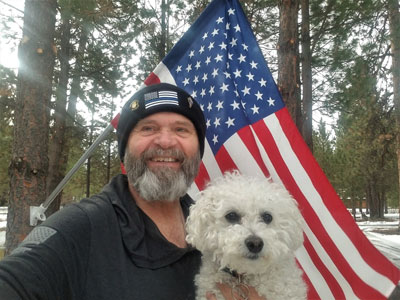
ABOUT THE AUTHOR — Greg Walker is a Special Forces veteran with service in both El Salvador and Iraq. He is the co-founder of Veterans of Special Operations – El Salvador (VSO-ES), the organization responsible for seeing the U.S. military campaign in that country authorized with an Armed Forces Expeditionary Medal by the Congress in 1996. Walker has been active in ongoing official efforts to achieve justice for the victims of the El Mozote massacre (1981) and the assassination of four Dutch journalists in El Salvador (1982). After his retirement in 2005, Walker continued to serve the Special Operations community as a DoD trained case manager and advocate with the SOCOM Care Coalition (2009-2013). Today he lives and writes along with his service pup, Tommy, in Sisters, Oregon.
[…] published in The Sentinel, the publication of the Special Forces Association, a very interesting article on Jennifer Casolo, an American activist arrested in a raid on her home in El Salvador during the civil war there in […]